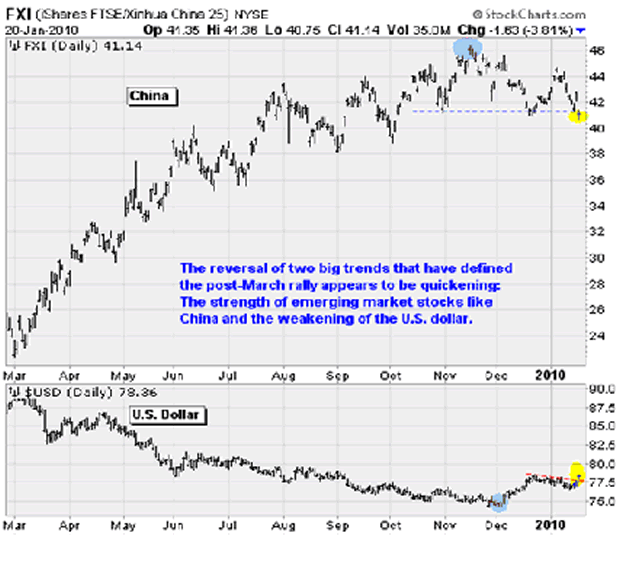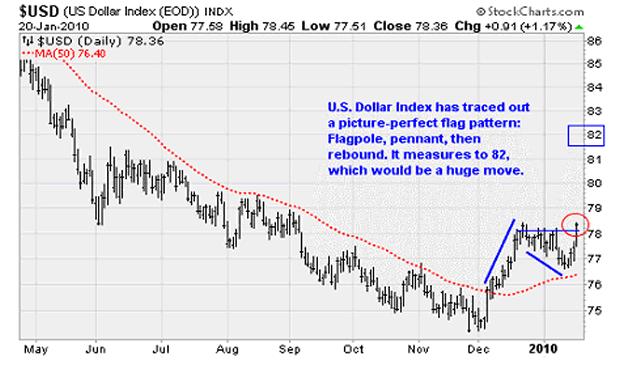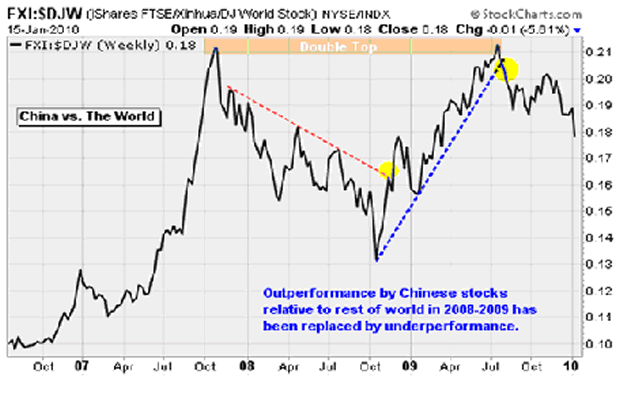Will the Stock Market Rebound from Last Week's Beating?
Stock-Markets / Stock Markets 2010 Jan 25, 2010 - 06:31 AM GMTBy: MoneyMorning
 Jon D. Markman writes: Stocks slipped sharply in the past three days as the underlying market weakness we've been highlighting for the past two weeks finally mattered. A number of better-than-expected earnings reports were ignored. Even the successful election of a Republican to one of Massachusetts' two Senate seats, which helped health-care stocks push the market up on Tuesday, wasn't enough.
Jon D. Markman writes: Stocks slipped sharply in the past three days as the underlying market weakness we've been highlighting for the past two weeks finally mattered. A number of better-than-expected earnings reports were ignored. Even the successful election of a Republican to one of Massachusetts' two Senate seats, which helped health-care stocks push the market up on Tuesday, wasn't enough.
Look at it this way: The sellers won a round, after being absolutely bludgeoned since last March.
One of the key catalysts has been word that Chinese authorities are ordering some banks to curb lending -- another sign that China is tightening monetary policy in an effort to forestall a runaway credit bubble. Or maybe it was the Chinese government's decision to pull James Cameron's fanciful and rebellious "Avatar" movie out of its theatres. It's easy to get caught up in the Chinese growth story and forget how oppressive the communist regime running the show there is; these people crushed students to death with tanks.


Valid or not, worries over emerging-market credit expansion and economic growth caused investors to push stocks down across Asia, Latin America and Europe. As traders moved away from risky assets, they moved into dividend-paying U.S. financial and energy stocks, and pushed the dollar up out of the bull flag pattern with a super-powerful 1.2% move.
We've been showing subscribers this developing pattern for two weeks. It measures potentially to 82, which would be a gigantic move if it occurs. The dollar surge put a lot of pressure on commodities all week, as crude oil, copper, lead and gold all fell. That in turn put pressure on commodity equities: Newmont Mining (NYSE: NEM) sank 4.2%, while Rio Tinto (NYSE ADR: RTP) fell 4.5%.
Expect more of the same if the dollar keeps moving higher. All of this raises warning flags. And it all fits with our forecast that stocks will stall for about 10 months or so. The professionals are looking at the same evidence and coming to similar conclusions. So they have simply started to make preparations by taking profits in their riskiest and most successful ideas.

You can already see this in the way old leaders are turning into laggards. Here's another view of the first chart on China. See how the iShares FTSE/Xinhua China 25 Index (NYSE: FXI), which demonstrated huge outperformance relative to the world for the better part of 2009, is now dragging along like a piece of road kill caught on the rear bumper of the global financial market.
The black line in the chart shows the ratio of FXI to the Dow Jones World Index ($DJW). When the black line rises, Chinese stocks are outperforming the world; when it falls, Chinese stocks are underperforming. Note that the whole 2007-2008 bear market began with a collapse in Chinese stocks relative to the world, and unfortunately that appears to have started again in the autumn.
Last week I observed that FXI needs to remain above $40.95 to avoid creating a "lower low" on a chart that already has set a "lower high." It closed on Friday at $39, so crunch time is here. Beware.
Message of Massachusetts
Let's think for a moment about the meaning and implications of the Massachusetts election. In many ways, the election was augured weeks ago as President Obama's ratings slumped. Polls show that most Americans do not like the way the administration has allowed its health-care reform package to be subverted by unpopular Senate leaders. Legislation was never the president's strength as a lawmaker, so it's not surprising that it has proven to be a tough hurdle in his first year.
In many ways the situation is 1992 all over again, when President William Jefferson Clinton's health care reform package was derailed amid public revolt. That forced Clinton to move to the middle to govern for the rest of his term, and we can only hope that the same happens now.
The fact of the matter is that it's not Obama and the Democrats that were rejected so much as the concept of government as usual. If Congress gets the hint, and pulls back on its deficit spending to blunt the hostility incumbents will face in the November mid-term elections, the result will likely be renewed confidence in the dollar and, in turn, U.S. Treasuries.
Cutbacks in fiscal policy could mean less support for economic stimulus, too, and that would be a negative for economic growth in the second half of the year -- another step that would be positive for bonds.
It's fascinating how so many different threads of fiscal, political and monetary policy are weaving together here at the start of the year to create fear, uncertainty and doubt -- the classic smokescreen behind which financial institutions do their dirty work. It's our job to try to see through the FUD to keep our portfolios on track. I've said all year that it was going to get very tricky very fast, and we're not disappointed in that forecast.
Overconfidence
Although there appears to be some very early rumblings of trouble, much remains calm on Wall Street. If you saw nothing but the Standard & Poor’s 500 Index right now in relation to its 12-month average, which defines the boundary of a bull cycle, is still well below the current levels of the major indexes.
In short, this is definitely still a positive market -- but it's one that threatens to become unstable rather quickly. This combination of surface serenity with turbulent currents makes me wary.
One example of misplaced calm: I noticed a story in the Financial Times on Tuesday about "old" General Motors Corp., which represents the unwanted assets and old liabilities of "new" government-owned General Motors. Shares in the company, now called Motors Liquidation Co., trade on the pink sheets and have risen due to opportunistic day-trading by hedge funds and penny stock manipulators. What I'm going to say here now is an oxymoron, but the "value" of this literally worthless paper puts the market capitalization of the bankrupt company at close to $500 million.
This comes days after emerging market debt was lifted out of "junk status" for the first time in history on the back of the best start to the year for foreign bonds since at least 1996. I hope that EM bonds never slip back into junk-land, but a cynic would say both situations are signs of overconfidence -- and reasons to tread carefully in other realms of the market.
Another way to view the phenomenon is through the CBOE Volatility Index ($VIX) or fear gauge. It measures the implied volatility of the stock market based on S&P 500 options trading. Until the big down sessions on Thursday and Friday, the VIX flattened out in a reflection of apparent calm. But on an intra-day basis we saw a number of large spikes upward (a reflection of fear) that were quickly reversed into the close.
It's almost as if someone was actively leaning on the VIX to keep it from rising too much. I've noticed similar characteristics near short-term market tops over the past year. And then came Friday, when the VIX jumped 20%. The closest analog was back in May 2008 -- which was one of the reaction highs reached during the October 2007 to March 2009 stock market meltdown.
This behavior could be an indication that large institutional traders were trying to keep the major indices elevated via stock options and futures while they unload large cash positions ahead of a period of weakness. This thesis fits with our recent observations of deteriorating market breadth and the likelihood of a long pause coming in equity prices.
For this reason, along with many others we've explored recently, we've been recommending a reduction in exposure to foreign stocks, at least for awhile. Ultimately, most of the growth is occurring in emerging markets. There's no doubt about that. But for awhile, expectations can get out of hand and bring sharp corrections that nimble investors can sidestep if they wish.
Week in review
Monday: Market closed for holiday.Tuesday: Stocks jumped to new 2010 closing highs on Monday, erasing Friday's losses. A larger-than-expected loss at Citigroup Inc. (NYSE: C) was largely ignored as traders focused on the outcome of today's special election for the Massachusetts Senate seat formerly held by the late Ted Kennedy.
The Republican contender waged a surprise come-from-behind campaign and has claimed victory. If validated, the win will cut the Democrat's Senate majority to 59 seats, which puts the pending healthcare reform legislation and the rest of the Obama Administration's legislative priorities in jeopardy.
Wednesday: New housing starts made a surprise drop in December, falling to a 557,000 annual rate when the consensus expected 579,000. This was a 4% fall compared to the 10.7% gain in November. However, new building permits jumped 10.9% after falling 6.9% in the previous months in a sign homebuilders are becoming more optimistic about the future.
A report on producer price inflation showed deflationary pressures continue to keep a lid on prices.
Thursday: Initial jobless claims made a surprise jump, rising to 482,000 against the consensus estimate of 444,000. It was the third-straight increase. The four-week moving average increased slightly, ending a streak of unbroken declines dating back to August. The Labor Department said the jump in claims was due to short holiday staffing at state unemployment processing centers, but investors interpreted the results as an indication the labor turnaround is going to be long in coming.
Separately, the index of leading economic indicators were very strong for December, jumped 1.1% compared to 0.7% in November thanks to a steep yield curve (low short-term rates and higher long-term rates) that benefits banks as well as an increase in building permits.
Friday: A string of positive earnings news. McDonald's Corp. (NYSE MCD) reported earnings of $1.11 per share against the $1.02 consensus estimate thanks to a 7.3% expansion in revenue. General Electric reported earnings of 28 cents, two cents over estimates.
The Week Ahead
Monday: A collection of Treasury auctions and an update on existing home sales.Tuesday: An update on consumer confidence and a check on home prices courtesy of the Case-Shiller Home Price Index. Also, the Federal Reserve begins its two-day policy meeting. Healthcare bellwether Johnson & Johnson (NYSE: JNJ) reports results.
Wednesday: New home sales for December will be reported. Federal Reserve announces its interest rate policy decision -- watch for wording on wind down of credit purchase programs. Caterpillar Inc. (NYSE: CAT) and The Boeing Co. (NYSE: BA) report results.
Thursday: Durable goods orders for December and initial jobless claims will be reported. Ford Motor Co. (NYSE: F) and Amazon.com Inc. (Nasdaq: AMZN) reports results.
Friday: A busy day. The government's initial estimate for fourth-quarter gross domestic product (GDP) will be released. Consensus is looking for a 4.5% expansion thanks to healthy holiday sales and heavy stimulus spending. Chevron (NYSE: CVX) reports results.
Source: http://moneymorning.com/2010/01/25/stocks-last-week/
Money Morning/The Money Map Report
©2010 Monument Street Publishing. All Rights Reserved. Protected by copyright laws of the United States and international treaties. Any reproduction, copying, or redistribution (electronic or otherwise, including on the world wide web), of content from this website, in whole or in part, is strictly prohibited without the express written permission of Monument Street Publishing. 105 West Monument Street, Baltimore MD 21201, Email: customerservice@moneymorning.com
Disclaimer: Nothing published by Money Morning should be considered personalized investment advice. Although our employees may answer your general customer service questions, they are not licensed under securities laws to address your particular investment situation. No communication by our employees to you should be deemed as personalized investment advice. We expressly forbid our writers from having a financial interest in any security recommended to our readers. All of our employees and agents must wait 24 hours after on-line publication, or 72 hours after the mailing of printed-only publication prior to following an initial recommendation. Any investments recommended by Money Morning should be made only after consulting with your investment advisor and only after reviewing the prospectus or financial statements of the company.
Money Morning Archive |
© 2005-2022 http://www.MarketOracle.co.uk - The Market Oracle is a FREE Daily Financial Markets Analysis & Forecasting online publication.



